雅思口语常见话题——食物运输问题
- 格式:docx
- 大小:38.20 KB
- 文档页数:4
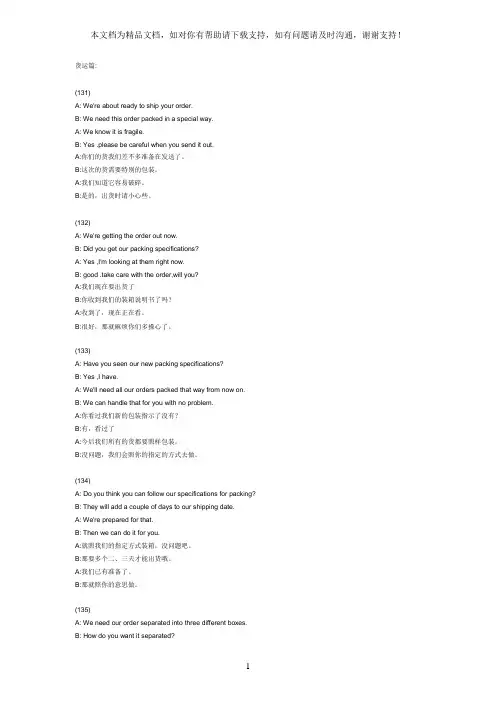
货运篇:(131)A: We're about ready to ship your order.B: We need this order packed in a special way.A: We know it is fragile.B: Yes .please be careful when you send it out.A:你们的货我们差不多准备在发送了。
B:这次的货需要特别的包装。
A:我们知道它容易破碎。
B:是的,出货时请小心些。
(132)A: We're getting the order out now.B: Did you get our packing specifications?A: Yes ,I'm looking at them right now.B: good .take care with the order,will you?A:我们现在要出货了B:你收到我们的装箱说明书了吗?A:收到了,现在正在看。
B:很好,那就麻烦你们多操心了。
(133)A: Have you seen our new packing specifications?B: Yes ,I have.A: We'll need all our orders packed that way from now on. B: We can handle that for you with no problem.A:你看过我们新的包装指示了没有?B:有,看过了A:今后我们所有的货都要照样包装。
B:没问题,我们会照你的指定的方式去做。
(134)A: Do you think you can follow our specifications for packing? B: They will add a couple of days to our shipping date.A: We're prepared for that.B: Then we can do it for you.A:就照我们的指定方式装箱,没问题吧。
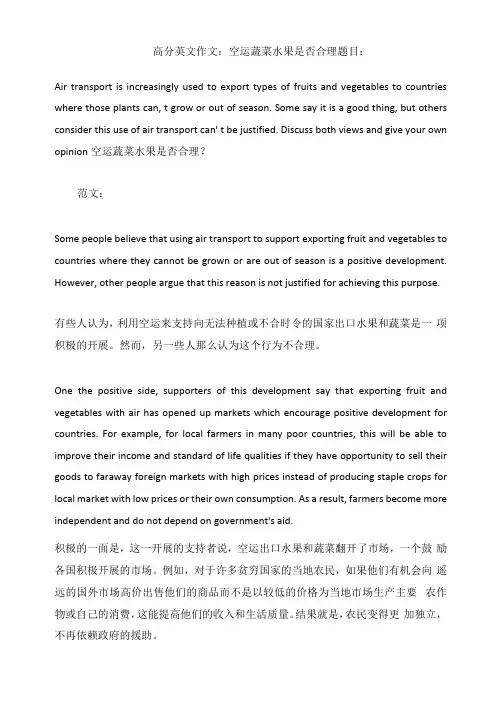
高分英文作文:空运蔬菜水果是否合理题目:Air transport is increasingly used to export types of fruits and vegetables to countries where those plants can, t grow or out of season. Some say it is a good thing, but others consider this use of air transport can' t be justified. Discuss both views and give your own opinion空运蔬菜水果是否合理?范文:Some people believe that using air transport to support exporting fruit and vegetables to countries where they cannot be grown or are out of season is a positive development. However, other people argue that this reason is not justified for achieving this purpose.有些人认为,利用空运来支持向无法种植或不合时令的国家出口水果和蔬菜是一项积极的开展。
然而,另一些人那么认为这个行为不合理。
One the positive side, supporters of this development say that exporting fruit and vegetables with air has opened up markets which encourage positive development for countries. For example, for local farmers in many poor countries, this will be able to improve their income and standard of life qualities if they have opportunity to sell their goods to faraway foreign markets with high prices instead of producing staple crops for local market with low prices or their own consumption. As a result, farmers become more independent and do not depend on government's aid.积极的一面是,这一开展的支持者说,空运出口水果和蔬菜翻开了市场,一个鼓励各国积极开展的市场。
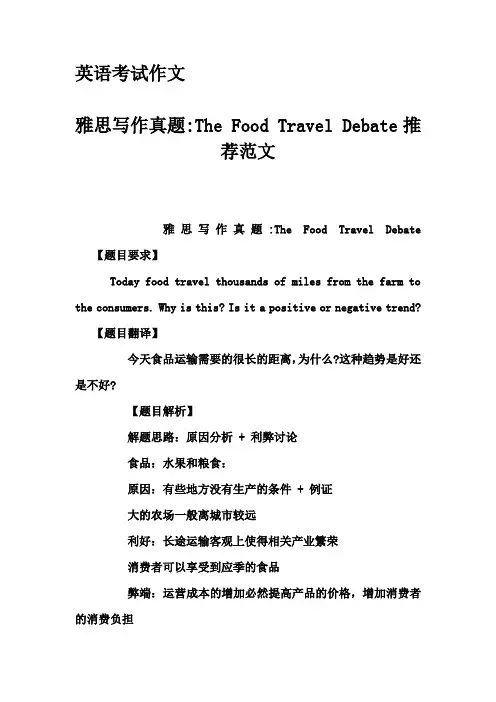
英语考试作文
雅思写作真题:The Food Travel Debate推
荐范文
雅思写作真题:The Food Travel Debate 【题目要求】
Today food travel thousands of miles from the farm to
the consumers. Why is this? Is it a positive or negative trend?
【题目翻译】
今天食品运输需要的很长的距离,为什么?这种趋势是好还
是不好?
【题目解析】
解题思路:原因分析 + 利弊讨论
食品:水果和粮食:
原因:有些地方没有生产的条件 + 例证
大的农场一般离城市较远
利好:长途运输客观上使得相关产业繁荣
消费者可以享受到应季的食品
弊端:运营成本的增加必然提高产品的价格,增加消费者
的消费负担
运输时间长,食品可能出现腐烂的现象
运输过程中可以产生大量的空气污染和噪音污染。
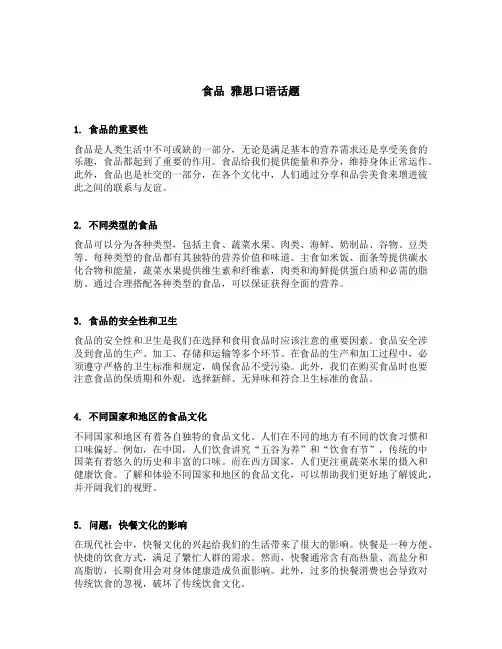
食品雅思口语话题1. 食品的重要性食品是人类生活中不可或缺的一部分,无论是满足基本的营养需求还是享受美食的乐趣,食品都起到了重要的作用。
食品给我们提供能量和养分,维持身体正常运作。
此外,食品也是社交的一部分,在各个文化中,人们通过分享和品尝美食来增进彼此之间的联系与友谊。
2. 不同类型的食品食品可以分为各种类型,包括主食、蔬菜水果、肉类、海鲜、奶制品、谷物、豆类等。
每种类型的食品都有其独特的营养价值和味道。
主食如米饭、面条等提供碳水化合物和能量,蔬菜水果提供维生素和纤维素,肉类和海鲜提供蛋白质和必需的脂肪。
通过合理搭配各种类型的食品,可以保证获得全面的营养。
3. 食品的安全性和卫生食品的安全性和卫生是我们在选择和食用食品时应该注意的重要因素。
食品安全涉及到食品的生产、加工、存储和运输等多个环节。
在食品的生产和加工过程中,必须遵守严格的卫生标准和规定,确保食品不受污染。
此外,我们在购买食品时也要注意食品的保质期和外观,选择新鲜、无异味和符合卫生标准的食品。
4. 不同国家和地区的食品文化不同国家和地区有着各自独特的食品文化。
人们在不同的地方有不同的饮食习惯和口味偏好。
例如,在中国,人们饮食讲究“五谷为养”和“饮食有节”,传统的中国菜有着悠久的历史和丰富的口味。
而在西方国家,人们更注重蔬菜水果的摄入和健康饮食。
了解和体验不同国家和地区的食品文化,可以帮助我们更好地了解彼此,并开阔我们的视野。
5. 问题:快餐文化的影响在现代社会中,快餐文化的兴起给我们的生活带来了很大的影响。
快餐是一种方便、快捷的饮食方式,满足了繁忙人群的需求。
然而,快餐通常含有高热量、高盐分和高脂肪,长期食用会对身体健康造成负面影响。
此外,过多的快餐消费也会导致对传统饮食的忽视,破坏了传统饮食文化。
可以通过以下方式来减少快餐对健康的影响:5.1. 增加家庭烹饪时间在快节奏的生活中,很多人往往没有时间烹饪食物,而选择了外卖或快餐。
为了改变这种情况,可以尝试增加家庭烹饪时间,学习健康的烹饪方法和食谱,让整个家庭一起享受烹饪和美食的乐趣。
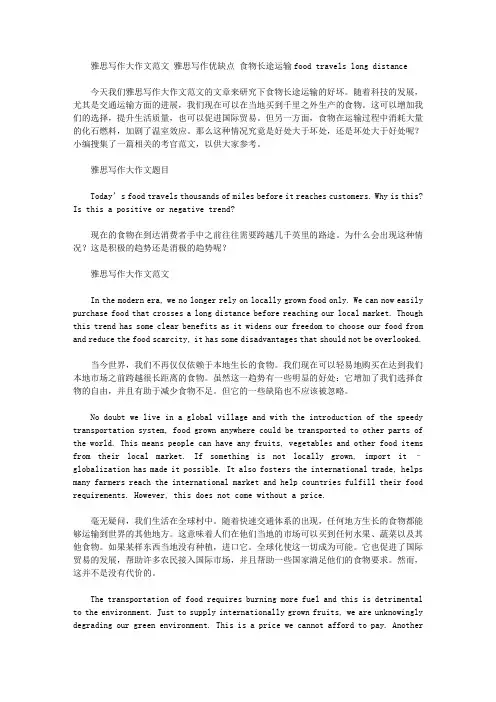
雅思写作大作文范文雅思写作优缺点食物长途运输food travels long distance今天我们雅思写作大作文范文的文章来研究下食物长途运输的好坏。
随着科技的发展,尤其是交通运输方面的进展,我们现在可以在当地买到千里之外生产的食物。
这可以增加我们的选择,提升生活质量,也可以促进国际贸易。
但另一方面,食物在运输过程中消耗大量的化石燃料,加剧了温室效应。
那么这种情况究竟是好处大于坏处,还是坏处大于好处呢?小编搜集了一篇相关的考官范文,以供大家参考。
雅思写作大作文题目Today’s food travels thousands of miles before it reaches customers. Why is this? Is this a positive or negative trend?现在的食物在到达消费者手中之前往往需要跨越几千英里的路途。
为什么会出现这种情况?这是积极的趋势还是消极的趋势呢?雅思写作大作文范文In the modern era, we no longer rely on locally grown food only. We can now easily purchase food that crosses a long distance before reaching our local market. Though this trend has some clear benefits as it widens our freedom to choose our food from and reduce the food scarcity, it has some disadvantages that should not be overlooked.当今世界,我们不再仅仅依赖于本地生长的食物。
我们现在可以轻易地购买在达到我们本地市场之前跨越很长距离的食物。
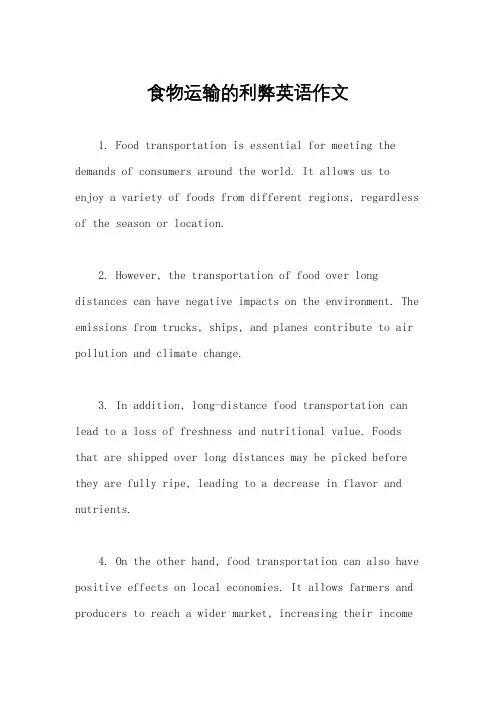
食物运输的利弊英语作文1. Food transportation is essential for meeting the demands of consumers around the world. It allows us to enjoy a variety of foods from different regions, regardless of the season or location.2. However, the transportation of food over long distances can have negative impacts on the environment. The emissions from trucks, ships, and planes contribute to air pollution and climate change.3. In addition, long-distance food transportation can lead to a loss of freshness and nutritional value. Foods that are shipped over long distances may be picked before they are fully ripe, leading to a decrease in flavor and nutrients.4. On the other hand, food transportation can also have positive effects on local economies. It allows farmers and producers to reach a wider market, increasing their incomeand supporting their livelihoods.5. Moreover, transporting food can help to address food shortages in areas where certain products are not readily available. It enables people to access a diverse range of foods that may not be locally produced.6. Despite the benefits of food transportation, it is important to consider the environmental and social costs. Finding a balance between meeting consumer demands and reducing the negative impacts of transportation is crucial for sustainable food systems.。
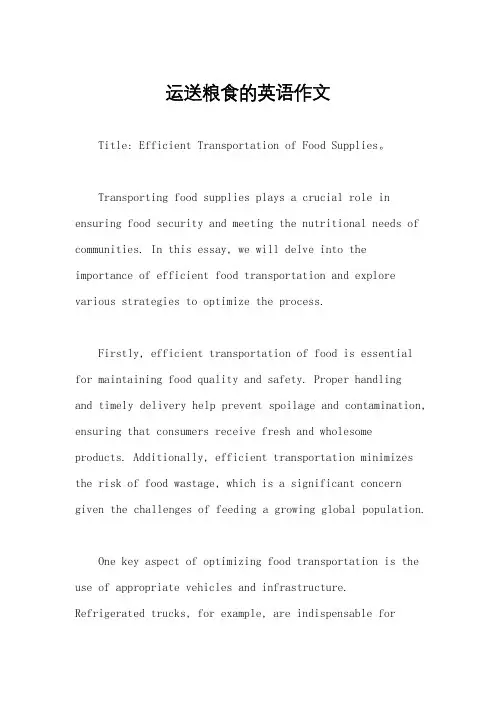
运送粮食的英语作文Title: Efficient Transportation of Food Supplies。
Transporting food supplies plays a crucial role in ensuring food security and meeting the nutritional needs of communities. In this essay, we will delve into the importance of efficient food transportation and explore various strategies to optimize the process.Firstly, efficient transportation of food is essential for maintaining food quality and safety. Proper handlingand timely delivery help prevent spoilage and contamination, ensuring that consumers receive fresh and wholesome products. Additionally, efficient transportation minimizes the risk of food wastage, which is a significant concern given the challenges of feeding a growing global population.One key aspect of optimizing food transportation is the use of appropriate vehicles and infrastructure.Refrigerated trucks, for example, are indispensable fortransporting perishable goods such as fruits, vegetables, and dairy products over long distances. Cold storagefacilities and refrigerated warehouses along transportation routes also play a critical role in preserving food quality.Furthermore, strategic planning and logistics management are essential for ensuring smooth and timely delivery of food supplies. This involves optimizing routes, scheduling deliveries, and coordinating with various stakeholders, including farmers, distributors, andretailers. Advanced technologies such as GPS tracking and route optimization software can help streamline logistics operations and minimize delays.Another important consideration in food transportationis the need for sustainability. As concerns about climate change and environmental degradation continue to grow,there is a growing emphasis on reducing the carbonfootprint of transportation activities. Strategies such as using energy-efficient vehicles, investing in renewable energy sources, and promoting alternative modes of transportation such as rail and waterways can help mitigatethe environmental impact of food transportation.In addition to efficiency and sustainability, equity and accessibility are also important principles to consider in food transportation. In many parts of the world, particularly in rural and remote areas, access to fresh and nutritious food can be limited due to inadequate transportation infrastructure. Addressing these disparities requires targeted interventions such as investment in rural roads, public transportation services, and community-based distribution networks.Moreover, in the face of global challenges such as the COVID-19 pandemic, resilience and adaptability areessential qualities in food transportation systems. The pandemic has disrupted supply chains and transportation networks, highlighting the need for contingency planning and risk management strategies. Building flexibility into transportation systems, diversifying supply sources, and fostering collaboration between public and private sectors can help enhance the resilience of food supply chains.In conclusion, efficient transportation of food supplies is vital for ensuring food security, preserving food quality, and promoting sustainable development. By leveraging appropriate technologies, optimizing logistics operations, and promoting equity and accessibility, we can build resilient and inclusive food transportation systems that meet the needs of present and future generations.。
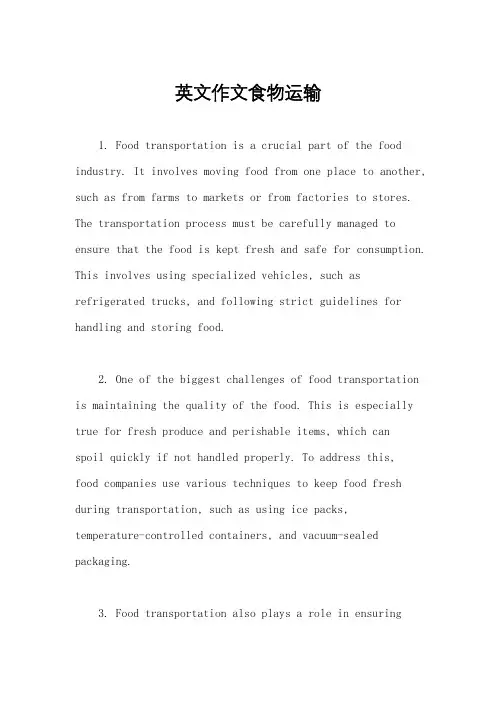
英文作文食物运输1. Food transportation is a crucial part of the food industry. It involves moving food from one place to another, such as from farms to markets or from factories to stores. The transportation process must be carefully managed to ensure that the food is kept fresh and safe for consumption. This involves using specialized vehicles, such as refrigerated trucks, and following strict guidelines for handling and storing food.2. One of the biggest challenges of food transportation is maintaining the quality of the food. This is especially true for fresh produce and perishable items, which canspoil quickly if not handled properly. To address this,food companies use various techniques to keep food fresh during transportation, such as using ice packs,temperature-controlled containers, and vacuum-sealed packaging.3. Food transportation also plays a role in ensuringthat people have access to a wide variety of foods. For example, many fruits and vegetables are grown in one part of the world but consumed in another. Transportation allows these foods to be distributed globally, giving people access to a diverse range of healthy and nutritious foods.4. Despite the importance of food transportation, it can also have negative impacts on the environment. The transportation of food requires large amounts of fuel, which contributes to greenhouse gas emissions and climate change. Additionally, the use of plastic packaging and other materials can contribute to waste and pollution. To address these issues, some companies are exploring more sustainable transportation methods, such as using electric vehicles or shipping food by rail.5. In conclusion, food transportation is a complex and important part of the food industry. It involves careful management of food quality, access to diverse foods, and sustainability considerations. As consumers, we can also play a role by supporting companies that prioritizesustainability and making conscious choices about the foods we consume.。
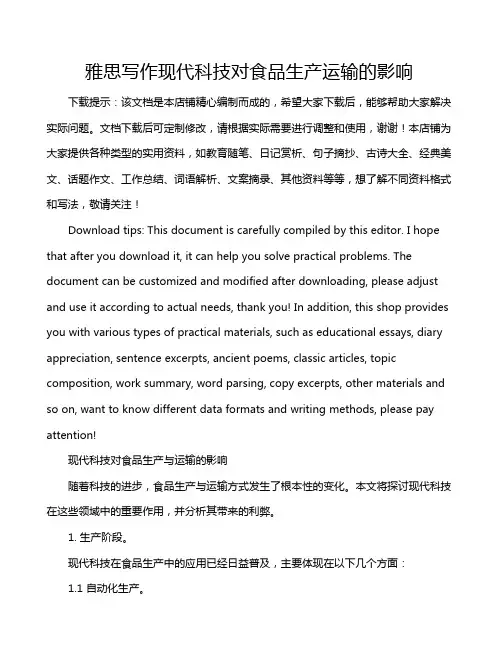
雅思写作现代科技对食品生产运输的影响下载提示:该文档是本店铺精心编制而成的,希望大家下载后,能够帮助大家解决实际问题。
文档下载后可定制修改,请根据实际需要进行调整和使用,谢谢!本店铺为大家提供各种类型的实用资料,如教育随笔、日记赏析、句子摘抄、古诗大全、经典美文、话题作文、工作总结、词语解析、文案摘录、其他资料等等,想了解不同资料格式和写法,敬请关注!Download tips: This document is carefully compiled by this editor. I hope that after you download it, it can help you solve practical problems. The document can be customized and modified after downloading, please adjust and use it according to actual needs, thank you! In addition, this shop provides you with various types of practical materials, such as educational essays, diary appreciation, sentence excerpts, ancient poems, classic articles, topic composition, work summary, word parsing, copy excerpts, other materials and so on, want to know different data formats and writing methods, please pay attention!现代科技对食品生产与运输的影响随着科技的进步,食品生产与运输方式发生了根本性的变化。
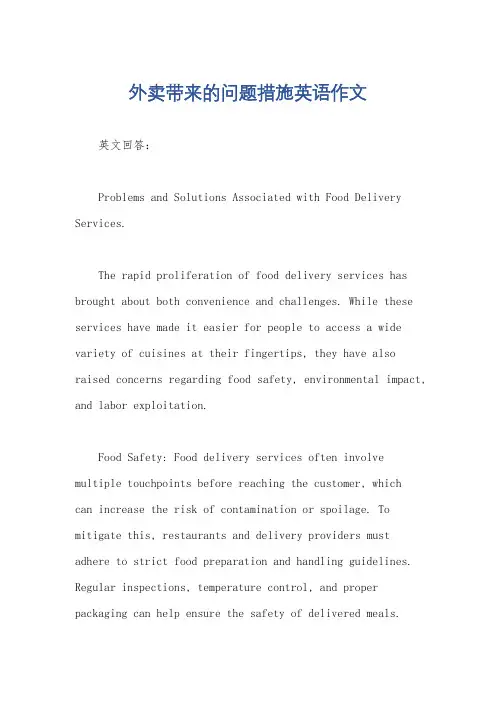
外卖带来的问题措施英语作文英文回答:Problems and Solutions Associated with Food Delivery Services.The rapid proliferation of food delivery services has brought about both convenience and challenges. While these services have made it easier for people to access a wide variety of cuisines at their fingertips, they have also raised concerns regarding food safety, environmental impact, and labor exploitation.Food Safety: Food delivery services often involve multiple touchpoints before reaching the customer, whichcan increase the risk of contamination or spoilage. To mitigate this, restaurants and delivery providers must adhere to strict food preparation and handling guidelines. Regular inspections, temperature control, and proper packaging can help ensure the safety of delivered meals.Environmental Impact: The use of disposable containers, plastic utensils, and delivery vehicles contributes to environmental pollution. To address this, delivery services should encourage the use of reusable packaging, promote energy-efficient delivery practices, and partner with local restaurants to reduce delivery distances.Labor Exploitation: Food delivery workers often face challenges, including low wages, lack of benefits, and precarious working conditions. To protect workers' rights, delivery services must establish fair compensation models, provide access to health insurance and paid time off, and implement policies to prevent exploitation and harassment.Additional Considerations:Quality Control: Ensuring the quality and consistency of food during delivery can be challenging. Delivery services should establish clear quality standards, provide feedback mechanisms for customers, and partner with restaurants that maintain high food preparation practices.Customer Service: Timely delivery, accurate orders, and efficient resolution of complaints are crucial for customer satisfaction. Delivery services should invest in training their staff, implement effective communication systems, and establish clear policies for handling customer inquiries.Technology Integration: Advancements in technology can enhance the efficiency and convenience of food delivery services. Innovations such as real-time tracking, automated dispatching, and contactless payments can improve the user experience and streamline operations.中文回答:外卖带来的问题及对策。
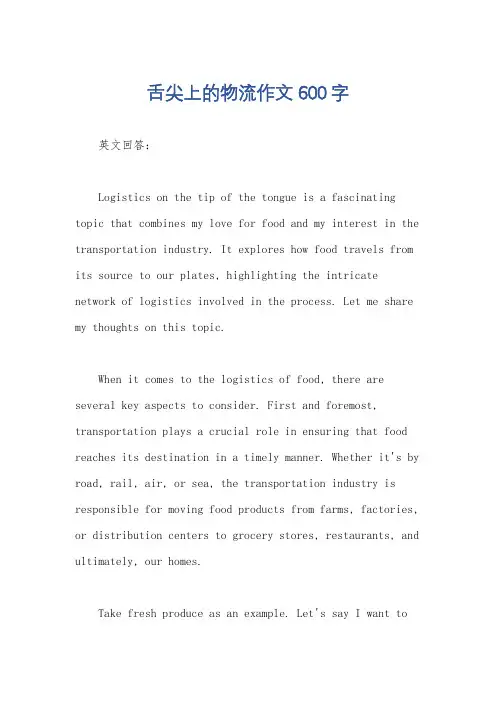
舌尖上的物流作文600字英文回答:Logistics on the tip of the tongue is a fascinating topic that combines my love for food and my interest in the transportation industry. It explores how food travels from its source to our plates, highlighting the intricate network of logistics involved in the process. Let me share my thoughts on this topic.When it comes to the logistics of food, there are several key aspects to consider. First and foremost, transportation plays a crucial role in ensuring that food reaches its destination in a timely manner. Whether it's by road, rail, air, or sea, the transportation industry is responsible for moving food products from farms, factories, or distribution centers to grocery stores, restaurants, and ultimately, our homes.Take fresh produce as an example. Let's say I want toenjoy a juicy watermelon during the winter season. Since watermelons are usually grown in warmer climates, they need to be transported over long distances to reach colder regions. This requires careful planning and coordination to ensure that the watermelons remain fresh and undamaged during transit. Temperature-controlled trucks or refrigerated containers on ships are commonly used to preserve the quality of perishable goods.Furthermore, the logistics of food also involves storage and warehousing. Food products need to be stored in appropriate conditions to maintain their freshness and prevent spoilage. Warehouses equipped with temperature control systems and proper inventory management ensure that food items are stored in optimal conditions until they are ready to be transported to their final destinations.In addition to transportation and storage, another crucial aspect of food logistics is packaging. Packaging not only protects food products from damage during transit but also plays a significant role in preserving their quality. For example, vacuum-sealed packaging helps toextend the shelf life of meat and dairy products, while airtight containers are used to store dry goods such as cereals and snacks. The packaging industry works closely with the food industry to develop innovative solutions that meet the specific needs of different food products.中文回答:舌尖上的物流是一个迷人的话题,它结合了我对食物的热爱和对运输行业的兴趣。
舌尖上的物流作文600字英文回答:Logistics on the Tip of My Tongue.When it comes to the topic of logistics, I must saythat it is something that plays a crucial role in our daily lives. Whether we realize it or not, logistics is everywhere, from the food we eat to the products we use. It is the backbone of our modern society, ensuring that goods are transported efficiently from one place to another.For instance, let's talk about the food we consume. Have you ever wondered how the fresh seafood from the coast ends up on your plate in a landlocked city? It's all thanks to logistics. The seafood is caught, packed, and transported to various distribution centers, where it is then delivered to local supermarkets or restaurants. Without an efficient logistics system, it would be impossible for us to enjoy such delicacies.Another example is the delivery of online shopping orders. With the rise of e-commerce, logistics has become even more important. When I order a new pair of shoes online, I expect them to be delivered to my doorstep within a few days. This seamless process involves multiple steps, including warehousing, picking and packing, and last-mile delivery. It's amazing how quickly and efficiently these logistics companies can get my package to me.中文回答:舌尖上的物流。
食物运输好坏英语作文Title: The Quality of Food Transportation: A Critical Analysis。
Introduction:Food transportation plays a crucial role in the global food supply chain, affecting the quality and safety of the products we consume. This essay examines the factors influencing the quality of food transportation and discusses its implications on food safety and consumer health.Factors Affecting Food Transportation Quality:1. Temperature Control: Maintaining the appropriate temperature during transportation is essential for preserving the freshness and quality of perishable foods. Refrigerated trucks, containers, and specialized packaging are used to control temperature fluctuations and preventspoilage.2. Hygiene and Sanitation: Proper cleaning and sanitization of transportation vehicles and containers are imperative to prevent contamination and foodborne illnesses. Regular maintenance and adherence to hygiene standards minimize the risk of microbial growth and ensure food safety.3. Packaging Integrity: The integrity of packaging materials is crucial in protecting food products from physical damage, moisture, and pests during transit. Secure and durable packaging helps preserve product quality and prevents contamination.4. Transportation Time and Distance: The duration and distance of transportation impact the quality of food products, especially perishables. Longer transit times increase the risk of spoilage and deterioration, necessitating efficient logistics and transportation routes to minimize delays.5. Handling Practices: Careful handling practices, including loading, unloading, and storage procedures, are essential to prevent physical damage and maintain product integrity. Proper training of personnel involved in food transportation is crucial to minimize risks and ensure quality control.Implications for Food Safety and Consumer Health:1. Quality Assurance: Effective monitoring and quality control measures throughout the transportation process are essential to safeguard food quality and safety. Regular inspections, audits, and adherence to regulatory standards help identify and address potential risks to prevent contamination and ensure consumer protection.2. Risk of Contamination: Inadequate temperature control, poor hygiene practices, and improper handling increase the risk of contamination during transportation, leading to foodborne illnesses and product recalls. Implementing stringent protocols and safety measures mitigate these risks and uphold food safety standards.3. Economic Impact: Food transportation issues, such as delays, spoilage, and recalls, not only pose health risks but also result in significant economic losses for producers, distributors, and retailers. Investing in efficient transportation infrastructure and technologies improves supply chain resilience and reduces financial losses associated with food waste and quality issues.Conclusion:In conclusion, the quality of food transportation plays a pivotal role in ensuring food safety, preserving product quality, and safeguarding consumer health. By addressing factors such as temperature control, hygiene, packaging integrity, and handling practices, stakeholders can enhance the efficiency and reliability of food transportation systems. Prioritizing quality assurance measures and regulatory compliance is essential to mitigate risks, minimize foodborne illnesses, and foster consumer confidence in the global food supply chain.。
食品运输的英语作文Food transportation is an essential part of the food supply chain. It involves the movement of food products from the place of production to the place of consumption. This process is crucial in ensuring that fresh and safe food reaches consumers in a timely manner. In this essay, we will explore the importance of food transportation, the challenges it faces, and the solutions to overcome these challenges.First and foremost, food transportation plays acritical role in ensuring that food products reach consumers in a timely manner. This is particularly important for perishable food items such as fruits, vegetables, and dairy products. Without efficient transportation, these products may spoil before reaching the market, leading to food waste and economic losses for producers. Additionally, timely transportation is essential for meeting consumer demand and maintaining a steady supply of food products in the market.Furthermore, food transportation is crucial for ensuring food safety. Proper transportation practices, such as maintaining the cold chain for perishable products, are essential for preventing foodborne illnesses. Temperature control during transportation is particularly important for products such as meat, seafood, and dairy, as improper handling can lead to the growth of harmful bacteria. Therefore, ensuring that food products are transported under the right conditions is essential for protecting consumer health.Despite its importance, food transportation faces several challenges. One of the main challenges is the need to transport food over long distances. As the global food supply chain has become increasingly complex, food products often need to travel long distances from the place of production to the place of consumption. This can lead to increased transportation costs, as well as potential delays and logistical challenges.Another challenge is the need to maintain the coldchain during transportation. Many food products, such as fresh produce and frozen foods, require specific temperature conditions to remain safe for consumption. However, maintaining the cold chain can be challenging, especially in regions with extreme weather conditions or inadequate infrastructure. This can lead to quality issues and food safety concerns during transportation.To address these challenges, several solutions can be implemented. One solution is to invest in improved transportation infrastructure and technology. This includes the development of cold storage facilities, refrigerated trucks, and temperature monitoring systems to ensure that food products are transported under the right conditions. Additionally, investing in efficient transportation routes and logistics can help reduce the time and cost of food transportation.Another solution is to promote sustainable transportation practices. This includes the use of eco-friendly vehicles and alternative fuels to reduce the environmental impact of food transportation. Additionally,promoting local and regional food systems can help reduce the need for long-distance transportation and support local farmers and producers.In conclusion, food transportation is an essential part of the food supply chain, ensuring that food products reach consumers in a timely and safe manner. Despite facing challenges such as long distances and the need for cold chain maintenance, there are solutions that can be implemented to improve food transportation. By investing in infrastructure, technology, and sustainable practices, we can ensure that food transportation remains efficient and sustainable for the future.。
英文作文食物运输英文:Food transportation is a crucial part of the food supply chain. It involves the movement of food products from one place to another, ensuring that people have access to a variety of fresh and preserved foods. There are various methods of food transportation, including trucks, trains, ships, and airplanes. Each method has its own advantages and disadvantages.Trucks are commonly used for short-distance transportation of food products. They are flexible and can reach remote areas, but they are also limited by the amount of goods they can carry. Trains are efficient for long-distance transportation and can carry large quantities of goods, but they are restricted to railway lines. Ships are ideal for transporting large quantities of food products across oceans, but they are slow and can be affected by weather conditions. Airplanes are the fastest mode oftransportation, but they are expensive and have limited capacity for goods.In my opinion, the most effective method of food transportation depends on the specific needs of the food products and the distance they need to travel. For example, perishable goods such as fruits and vegetables may require fast transportation methods like airplanes to maintaintheir freshness. On the other hand, non-perishable goods like canned foods can be transported by ships or trains over longer distances.Food transportation also plays a significant role in the global economy. It allows countries to trade and exchange a variety of food products, contributing to economic growth and development. For instance, the transportation of coffee beans from South America to various parts of the world enables people to enjoy their favorite coffee blends.中文:食品运输是食品供应链的一个关键部分。
食物运输服务在中国是否成熟的英文作文I would like to list a few reasons why food travels so far these days. Firstly. a variety of food is unable to be produced locally, most notably in condensed cities. Moreover. since living standards have improved.there is an increased demand for a selection of foods. Asa result.consumers nowadays have widened their pallets and desire flavors from regions other than their own.Secondly, the logistics and development of food travel,such as the common use of air-planes for shipping, has made distribution fast and convenient. Hence freshly harvested food can be received by its consumers nearly in its original condition.A third reason is that food preservation technology, such as quality refrigeration,has become so advanced that food can be kept during travel and in supermarkets until it reaches the consumers' dinner tables without going bad.I believe that distant food travel is a positive trend because it provides more food selection for consumers. Additionally. it is healthier because people can enjoy freshly picked foods and asufficient range of choices to consume most recommended daily nutrients.译文:我将讨论目前食品远距离运输的原因。
雅思口语常见话题——食物运输问题
一、审题
Nowadays,food travel thousands of miles from farmers to consumers. Why does this happen? Is it a positive or negative trend?
写作类型:混合型:原因分析+观点,我们需要回答题目中的两个问题,我们写作的重点是观点表达部分。
题目关键词:食物/农民/消费者
分析法:主体分析法
出发点:关键词分别分析
二、思路分析
A 对原因的分析
1. 世界化的影响(globalization tendency)
2. 交通条件的改善(convenient transportation)
3. 生活水平的提升(living standard improving)
B 对观点的分析
食物:
积极影响——食物是经济活动中一个商品的角色,能够促动经济的发展。
(commodity——economy)
消极影响——食物需要适当的交通工具,而交通工具需要大量的燃料,这会造成会环境的破坏。
(vehicle——environment)
农民:
积极影响——食物的来源方,能够提升自己的收入。
(raising income)
积极影响——食物的消费方,能够丰富自己的饮食生活。
(enjoying rich food)
消费者:
积极影响——更多选择(more choice,oversea foods)
消极影响——食品安全(food security,stale food)
从题目中的三个关键词出发,我们能够得到一些积极因素,也能
够得到一些消极因素,同学们能够根据自己的观点来选择不同的因素。
三、话题整合
相关话题一
Some people argue that air transport can bring us more choices while others claim it makes agricultural and
industrial cost more. Discuss both views and give your own opinion.
与前面话题相比,第二个话题的特点:
食物——交通
笼统——具体
话题素材:
1. 空运的优缺点
空运的优点
Not only is air transport good for consumers, it is also a blessing for farmers because the market is no longer
restricted by regions. As a result,air transport increases the sale volume by selling more products in more places.
空运的缺点
The aircrafts have small carrying capacity and therefore these are not suitable for carrying bulky and cheaper goods. The load capacity cannot be increased as it is found in case of rails.
2. 食物的多样性与安全
3. 世界化对生活的影响
四、相关的表达
1. 基础词汇
Food miles
Win-win trade practice
Commercial globalization
Expand their share of market
National food security
优势:
Producing this food has transformed communities. Now young people want to stay in farming because there is money and a future in it. They can have smart phones and good clothes by living here not in a city.
劣势:。